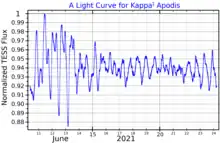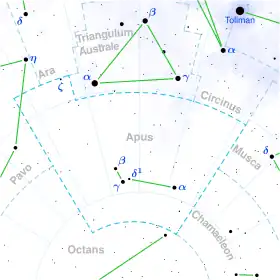Kappa1 Apodis
Kappa1 Apodis, Latinized from κ1 Apodis, is the Bayer designation for a binary star[3] system in the southern circumpolar constellation of Apus. Based upon parallax measurements, it is located roughly 1,060 light-years (325 parsecs) from Earth. The combined apparent visual magnitude of the system is 5.52,[2] indicating that this is a faint, naked eye star that can be viewed in dark suburban skies. It is moving away from the Sun with a radial velocity of +62 km/s.[5]

 | |
| Observation data Epoch J2000 Equinox J2000 | |
|---|---|
| Constellation | Apus |
| Right ascension | 15h 31m 30.82213s[1] |
| Declination | −73° 23′ 22.5295″[1] |
| Apparent magnitude (V) | 5.52[2] |
| Characteristics | |
| Spectral type | B1npe[3] |
| U−B color index | −0.791[2] |
| B−V color index | −0.128[2] |
| Variable type | γ Cas[4] |
| Astrometry | |
| Radial velocity (Rv) | +62[5] km/s |
| Proper motion (μ) | RA: +0.996[1] mas/yr Dec.: −18.345[1] mas/yr |
| Parallax (π) | 3.0798 ± 0.0717 mas[1] |
| Distance | 1,060 ± 20 ly (325 ± 8 pc) |
| Absolute magnitude (MV) | −2.47[6] |
| Details | |
| Mass | 12.0±0.3[7] M☉ |
| Luminosity | 2,120[6] L☉ |
| Surface gravity (log g) | 3.90[8] cgs |
| Temperature | 21,500[8] K |
| Age | 5.6±1.0[7] Myr |
| Other designations | |
| Database references | |
| SIMBAD | data |
This is a spectroscopic binary system with an orbital period of 0.6 days.[3] The combined spectrum matches a stellar classification of B1npe.[3] The 'e' suffix indicates that this is a Be star with emission lines in the spectrum. An 'n' means that the absorption lines in the spectrum are broadened from the Doppler effect as a result of rapid rotation. Finally, the 'p' shows some peculiarity in the spectrum. It is classified as a Gamma Cassiopeiae type variable star and its brightness varies from magnitude +5.43 to +5.61.
This is a runaway star with a peculiar velocity of 69.8±4.7 km/s.[7] Because it is a binary star system, it was most likely not turned into a runaway system as the result of a supernova explosion.[3] A companion star is a 12th magnitude orange K-type subgiant located at an angular separation of 27 arcseconds.
See also
References
- Vallenari, A.; et al. (Gaia collaboration) (2023). "Gaia Data Release 3. Summary of the content and survey properties". Astronomy and Astrophysics. 674: A1. arXiv:2208.00211. Bibcode:2023A&A...674A...1G. doi:10.1051/0004-6361/202243940. S2CID 244398875. Gaia DR3 record for this source at VizieR.
- Gutierrez-Moreno, Adelina; Moreno, Hugo (June 1968), "A photometric investigation of the Scorpio-Centaurus association", Astrophysical Journal Supplement, 15: 459, Bibcode:1968ApJS...15..459G, doi:10.1086/190168.
- Jilinski, E.; et al. (September 2010), "A Dynamical Study of Suspected Runaway Stars as Traces of Past Supernova Explosions in the Region of the Scorpius-Centaurus OB Association", The Astrophysical Journal, 721 (1): 469–477, Bibcode:2010ApJ...721..469J, doi:10.1088/0004-637X/721/1/469.
- Samus, N. N.; Durlevich, O. V.; et al. (2009), "VizieR Online Data Catalog: General Catalogue of Variable Stars (Samus+ 2007–2013)", VizieR On-line Data Catalog: B/gcvs, 1: 02025, Bibcode:2009yCat....102025S.
- Evans, D. S. (June 20–24, 1966), "The Revision of the General Catalogue of Radial Velocities", in Batten, Alan Henry; Heard, John Frederick (eds.), Determination of Radial Velocities and their Applications, Proceedings from IAU Symposium no. 30, vol. 30, University of Toronto: International Astronomical Union, p. 57, Bibcode:1967IAUS...30...57E.
- Anderson, E.; Francis, Ch. (2012), "XHIP: An extended hipparcos compilation", Astronomy Letters, 38 (5): 331, arXiv:1108.4971, Bibcode:2012AstL...38..331A, doi:10.1134/S1063773712050015, S2CID 119257644.
- Tetzlaff, N.; Neuhäuser, R.; Hohle, M. M. (January 2011), "A catalogue of young runaway Hipparcos stars within 3 kpc from the Sun", Monthly Notices of the Royal Astronomical Society, 410 (1): 190–200, arXiv:1007.4883, Bibcode:2011MNRAS.410..190T, doi:10.1111/j.1365-2966.2010.17434.x, S2CID 118629873.
- Soubiran, C.; Le Campion, J.-F.; Cayrel de Strobel, G.; Caillo, A. (June 2010), "The PASTEL catalogue of stellar parameters", Astronomy and Astrophysics, 515: A111, arXiv:1004.1069, Bibcode:2010A&A...515A.111S, doi:10.1051/0004-6361/201014247, S2CID 118362423.
- "HR 5730", SIMBAD, Centre de données astronomiques de Strasbourg, retrieved 2012-07-08.
- MAST: Barbara A. Mikulski Archive for Space Telescopes, Space Telescope Science Institute, retrieved 8 December 2021.